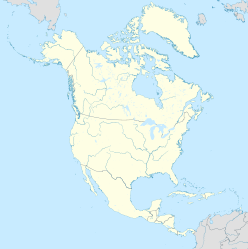
Back Chicxulub-krater AF فوهة تشيكشولوب Arabic Чыксулуб BE Чиксулуб Bulgarian চিকশুলুব খাদ Bengali/Bangla Krater Chicxulub BR Cràter de Chicxulub Catalan Chicxulubský kráter Czech Chicxulub-krateret Danish Chicxulub-Krater German
| Chicxulub impact structure | |
 | |
| Impact crater/structure | |
|---|---|
| Confidence | Confirmed |
| Diameter | 180 km (110 mi) |
| Depth | 20 km (12 mi) |
| Impactor diameter | 10 kilometers (6.2 mi) |
| Age | 66.043 ± 0.043 Ma Cretaceous–Eocene boundary[2] |
| Exposed | No |
| Drilled | Yes |
| Bolide type | CM or CR type carbonaceous chondrite |
| Location | |
| Coordinates | 21°24′0″N 89°31′0″W / 21.40000°N 89.51667°W |
| Country | Mexico |
| State | Yucatán |
The Chicxulub crater is a large meteorite crater. It was probably made by the meteor that caused the extinction of the dinosaurs and other animals ~65 mya. It is partly in the Yucatán Peninsula in Mexico and partly underwater.
The Chicxulub crater is more than 180 km (110 mi) in diameter, making it the third largest confirmed impact crater on Earth.[3] Petroleum prospectors found it in the late 1970s.
The bolide which formed the crater was at least 10 km (6 mi) in diameter. Evidence for the impact origin of the crater includes shocked quartz, a gravity anomaly, and tektites in surrounding areas. The age of the rocks and isotope analysis show that this impact structure dates from the end of the Cretaceous period, roughly 66 million years ago. The impact which caused the crater probably caused the Cretaceous–Tertiary extinction event.
In March 2010, following analysis of the available evidence covering 20 years' worth of data in the fields of palaeontology, geochemistry, climate modelling, geophysics and sedimentology, 41 international experts from 33 institutions reviewed available evidence. They said the impact at Chicxulub triggered the mass extinctions during the K-T boundary, including that of dinosaurs.[4][5]
Scientists can now describe in detail how the asteroid that wiped out the dinosaurs produced its huge crater.[6] The reconstruction of the event 66 million years ago was made possible by drilling into the remnant bowl and analysing its rocks.
- ↑ "PIA03379: Shaded Relief with Height as Color, Yucatan Peninsula, Mexico". Shuttle Radar Topography Mission. NASA. Archived from the original on March 13, 2017. Retrieved October 28, 2010.
- ↑ Renne, P. R.; Deino, A. L.; Hilgen, F. J.; Kuiper, K. F.; Mark, D. F.; Mitchell, W. S.; Morgan, L. E.; Mundil, R.; Smit, J. (2013). "Time Scales of Critical Events Around the Cretaceous-Paleogene Boundary" (PDF). Science. 339 (6120): 684–687. Bibcode:2013Sci...339..684R. doi:10.1126/science.1230492. ISSN 0036-8075. PMID 23393261. S2CID 6112274. Archived (PDF) from the original on April 3, 2018. Retrieved July 28, 2017.
- ↑ Earth Impact Data Base
- ↑ Schulte, Peter; et al. (2010). "The Chicxulub asteroid impact and mass extinction at the Cretaceous–Paleogene boundary". Science. 327 (5970). AAAS: 1214–1218. Bibcode:2010Sci...327.1214S. doi:10.1126/science.1177265. ISSN 1095-9203. PMID 20203042. S2CID 2659741. Retrieved 5 March 2010.
- ↑ Rincon, Paul (2010-03-04). "Dinosaur extinction link to crater confirmed". BBC. Retrieved 2010-03-05.
- ↑ Amos, Jonathan 2019. Asteroid strike made 'instant Himalayas'. BBC News Science & Environment. [1]

